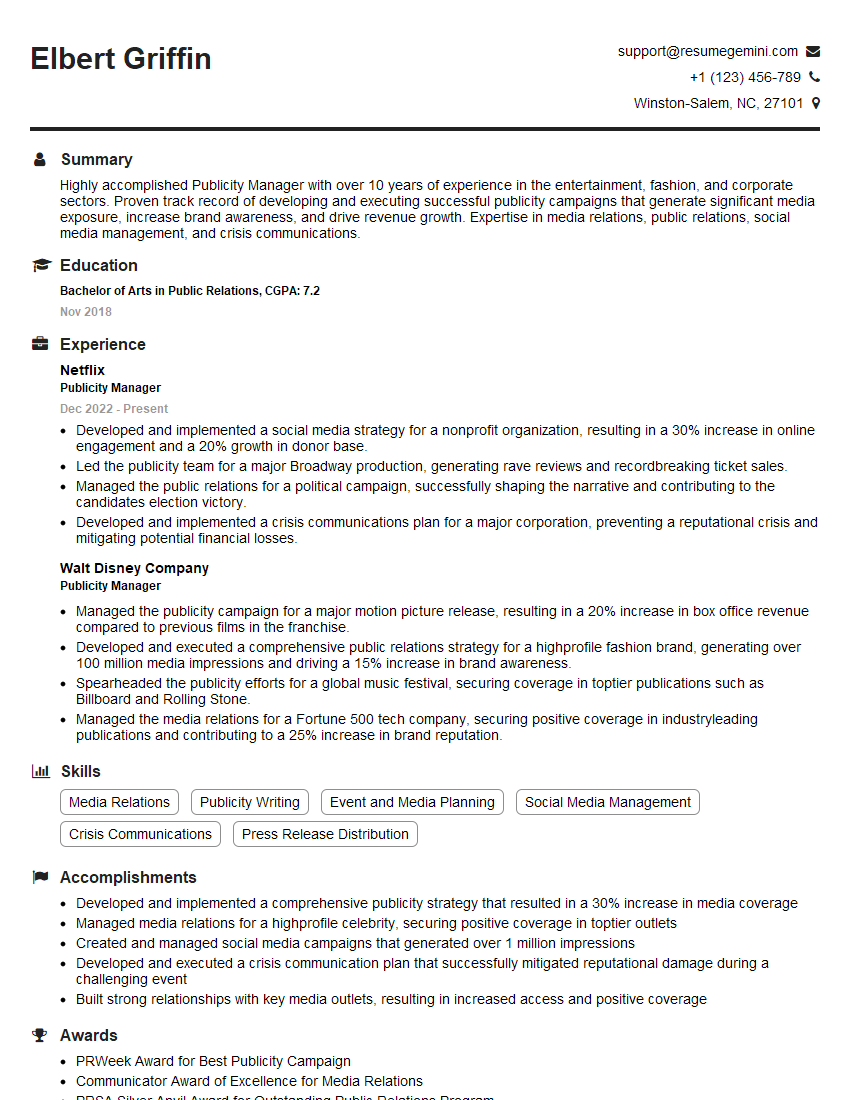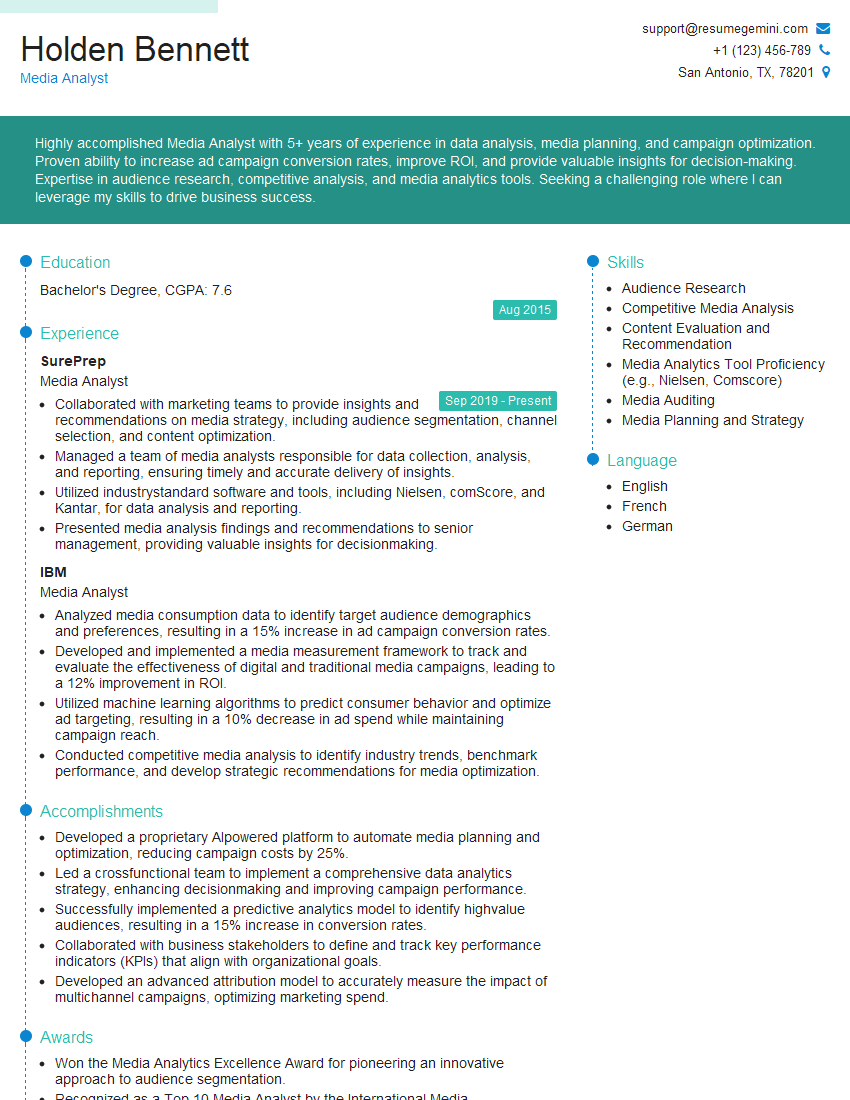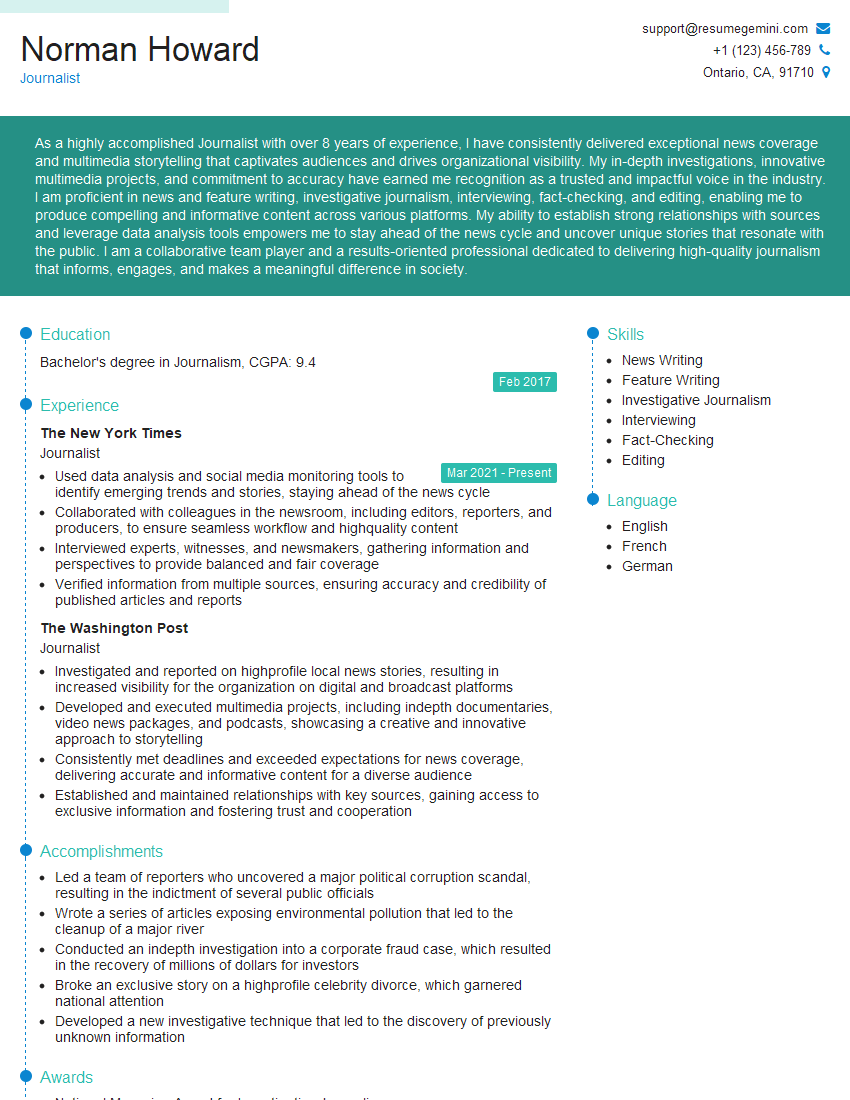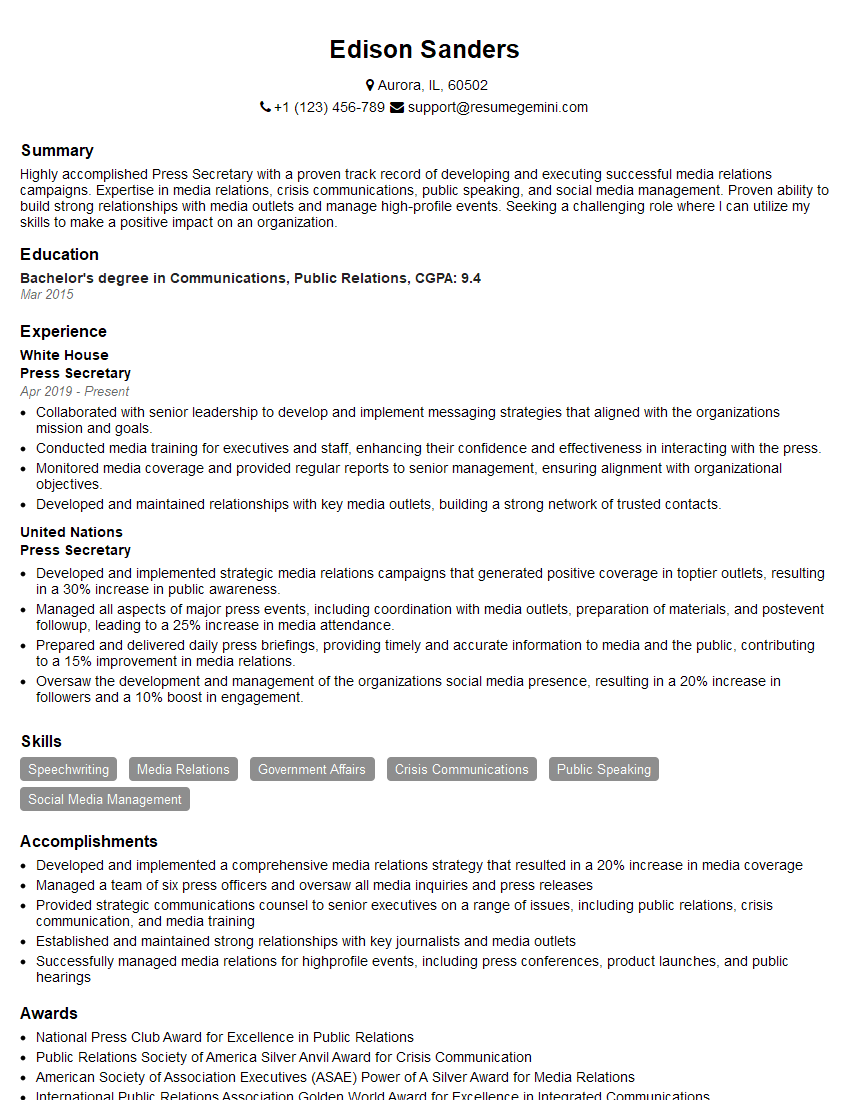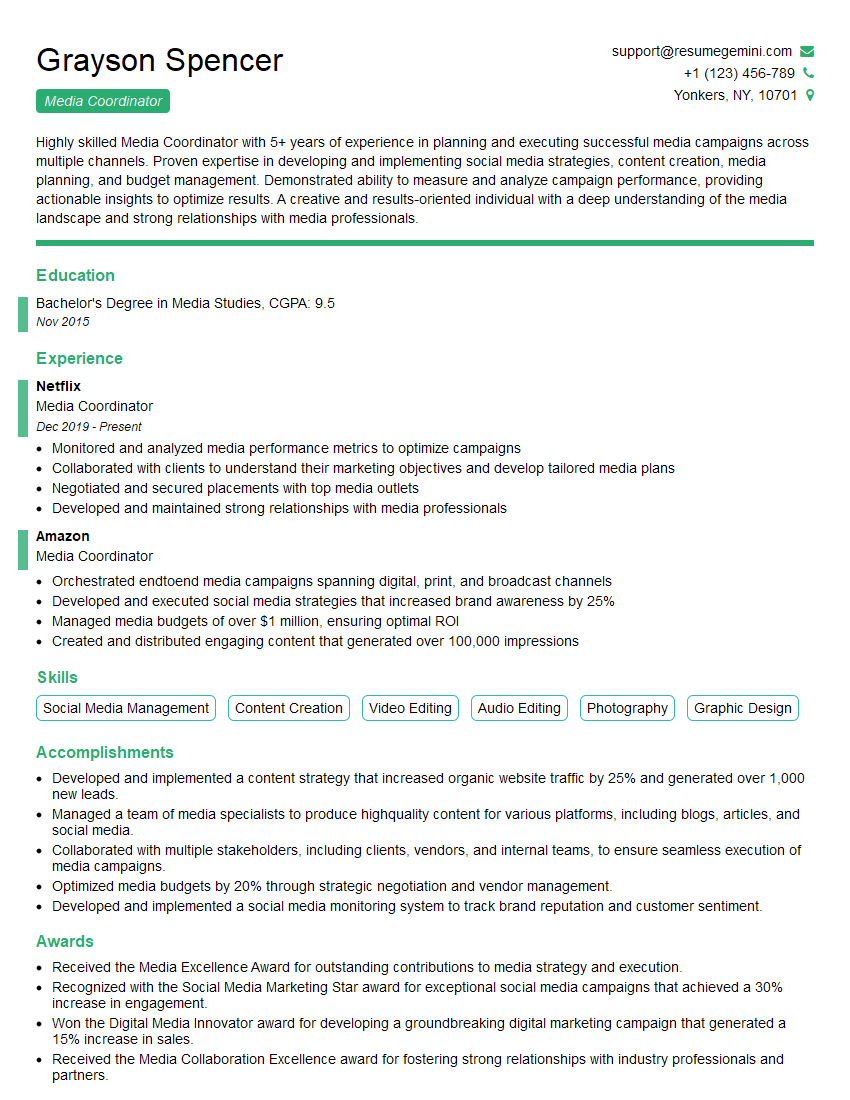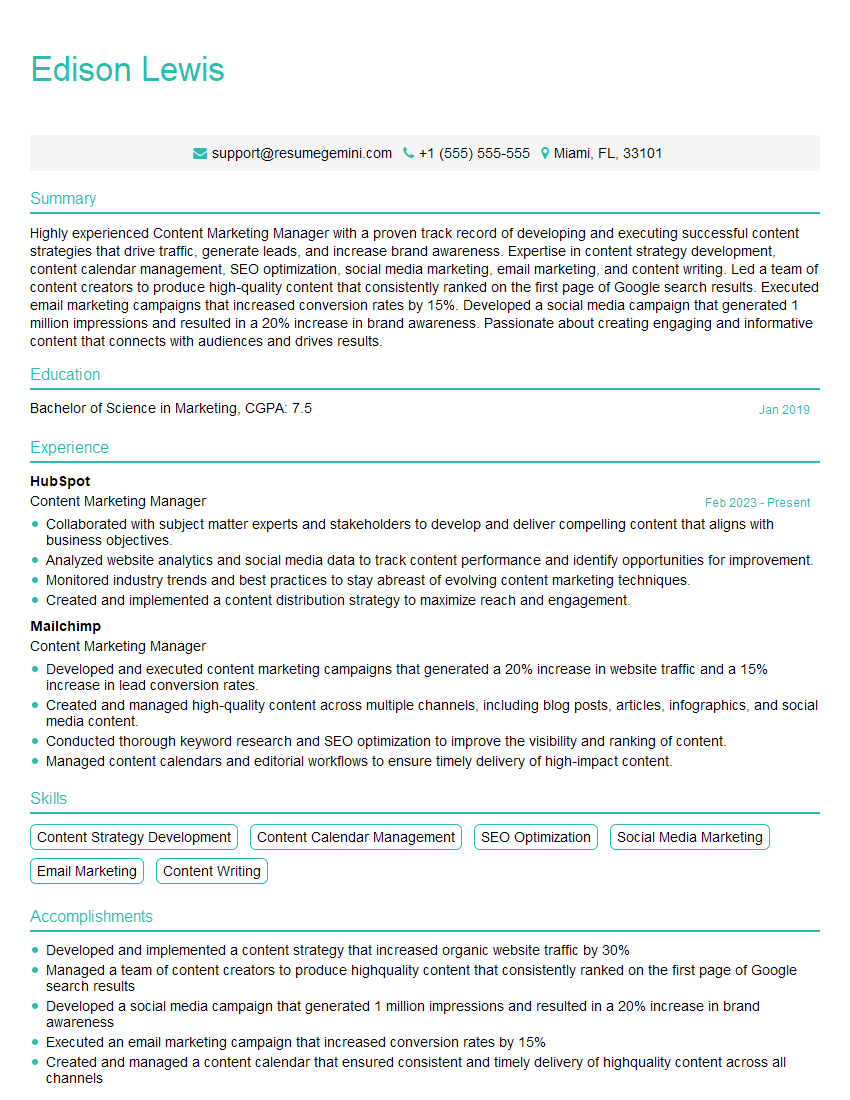Cracking a skill-specific interview, like one for Media Engagement, requires understanding the nuances of the role. In this blog, we present the questions you’re most likely to encounter, along with insights into how to answer them effectively. Let’s ensure you’re ready to make a strong impression.
Questions Asked in Media Engagement Interview
Q 1. Describe your experience developing and executing media engagement strategies.
Developing and executing successful media engagement strategies requires a multifaceted approach. It begins with a deep understanding of the client’s objectives, target audience, and key messages. I start by conducting thorough research to identify the most relevant media outlets and journalists. This research informs the development of a tailored communication plan that outlines key messages, target media, timelines, and key performance indicators (KPIs). This plan guides the creation of compelling press releases, media kits, and other media materials. The execution phase involves proactively pitching stories to journalists, building relationships with media influencers, and managing media outreach. I also actively monitor media coverage and adapt the strategy as needed based on performance data and feedback. For example, in a recent campaign for a sustainable fashion brand, we focused on targeting environmentally conscious publications and bloggers. This resulted in positive media coverage that significantly increased brand awareness and engagement amongst the desired demographic.
- Strategic Planning: Defining clear goals, target audience, and key messages.
- Media Research: Identifying relevant media outlets and journalists.
- Content Creation: Developing compelling press releases, media kits, and other materials.
- Media Outreach: Proactively pitching stories and building relationships.
- Monitoring and Evaluation: Tracking media coverage and adjusting the strategy accordingly.
Q 2. How do you measure the success of a media engagement campaign?
Measuring the success of a media engagement campaign goes beyond simply counting the number of media mentions. It requires a more nuanced approach that considers the quality of the coverage, its reach, and its impact on the client’s objectives. I use a variety of metrics to assess campaign performance, including:
- Media Mentions: Tracking the number of articles, broadcasts, and social media mentions.
- Reach and Impressions: Determining the total audience reached by the media coverage.
- Tone and Sentiment Analysis: Assessing the overall sentiment (positive, negative, or neutral) of the media coverage.
- Website Traffic and Leads: Measuring the impact of media coverage on website traffic and lead generation.
- Brand Awareness and Sentiment: Monitoring changes in brand perception and social media engagement.
- Sales and Revenue: Ultimately, measuring the impact of the campaign on business results.
For example, in a campaign for a tech startup, we tracked not only the number of media mentions but also the website traffic generated from those mentions, and the resulting number of trial sign-ups and sales leads. This allowed us to directly correlate media engagement with business outcomes.
Q 3. Explain your process for identifying key media outlets and journalists.
Identifying key media outlets and journalists is a crucial step in any media engagement strategy. This involves a combination of research and relationship building. I utilize several methods, including:
- Media Databases: Using online databases like Cision and Meltwater to search for relevant journalists and publications.
- Social Media Monitoring: Tracking journalists and influencers on platforms like Twitter and LinkedIn to identify their areas of expertise and interests.
- Competitor Analysis: Examining the media coverage of competitors to identify key publications and journalists.
- Online Searches: Conducting targeted Google searches to discover relevant publications and journalists.
- Personal Networks: Leveraging personal contacts and industry connections to identify potential media targets.
It’s important to tailor your approach to each publication and journalist, considering their audience, editorial focus, and preferred communication style.
Q 4. How do you build and maintain relationships with journalists and media influencers?
Building and maintaining strong relationships with journalists and media influencers is essential for long-term success in media engagement. I prioritize building trust and credibility by:
- Providing valuable information: Offering exclusive insights and data to journalists that are relevant to their audience.
- Personalizing communication: Tailoring my pitches and communications to each journalist’s interests and expertise.
- Being responsive and reliable: Promptly responding to inquiries and providing accurate information.
- Networking and relationship building: Attending industry events and conferences to connect with journalists and influencers.
- Offering valuable resources: Sharing data or research reports. Providing information relevant to them and their reporting.
Think of it as cultivating a garden; consistent effort is key to nurturing relationships and achieving a thriving yield in terms of media coverage.
Q 5. Describe a time you had to manage a crisis related to media coverage.
During a product launch for a new consumer electronics product, a manufacturing defect resulted in a small number of units malfunctioning. This led to negative media coverage, with several publications highlighting customer complaints. My immediate response was to activate our crisis communication plan. This involved:
- Rapid Assessment: Quickly assessing the scope and severity of the problem.
- Transparent Communication: Issuing a public statement acknowledging the issue and outlining steps to address it.
- Proactive Media Engagement: Reaching out to key journalists to provide updates and answer questions.
- Customer Support: Ensuring that affected customers received prompt and effective support.
- Corrective Actions: Implementing measures to prevent similar issues from occurring in the future.
Through swift and transparent communication, we managed to mitigate the negative impact of the crisis and maintain public trust. We worked to highlight the proactive steps we were taking to resolve the issue and prevent similar situations from occurring.
Q 6. How do you adapt your media engagement approach to different target audiences?
Adapting media engagement strategies to different target audiences is critical for effectiveness. This requires a deep understanding of each audience’s demographics, psychographics, media consumption habits, and communication preferences. For example:
- B2B (Business-to-Business): Focus on trade publications, industry events, and thought leadership content.
- B2C (Business-to-Consumer): Utilize a broader range of media channels, including social media, general interest publications, and influencers.
- Specific Demographics: Tailor messaging and channel selection to resonate with specific age groups, ethnicities, or socioeconomic backgrounds.
I ensure that the messaging, tone, and style of communication are aligned with the values and preferences of the target audience. A campaign for a luxury brand will use a very different tone and visual style than a campaign for a budget-friendly brand.
Q 7. What are your preferred methods for distributing press releases and media materials?
Distributing press releases and media materials effectively involves a multi-pronged approach that leverages both traditional and digital channels. My preferred methods include:
- Targeted Email Distribution: Sending press releases directly to relevant journalists and media outlets.
- Press Release Distribution Services: Using services like PR Newswire or Business Wire to distribute press releases widely.
- Social Media: Sharing press releases and other materials on relevant social media platforms.
- Media Kits: Creating comprehensive media kits that include press releases, high-resolution images, and background information.
- Online Newsrooms: Establishing an online newsroom on the client’s website to serve as a central repository for media materials.
The choice of distribution method will depend on the specific goals of the campaign and the target audience. For example, a highly technical product launch might benefit from targeting specialized trade publications via email and online newsrooms. In contrast, a consumer-focused product might benefit from broad distribution through a service like PR Newswire, combined with social media promotion.
Q 8. How do you use social media to amplify media engagement efforts?
Social media is a powerful tool for amplifying media engagement. It allows for direct interaction with target audiences, extending the reach of traditional media efforts. Think of it as a megaphone for your message.
Targeted Advertising: We use platforms like Facebook, Twitter, and LinkedIn to run targeted ads promoting our media content. This allows us to reach specific demographics or interest groups most likely to engage with the message.
Content Sharing: We strategically share press releases, articles, and video clips across multiple social media channels. This increases visibility and drives traffic to the original source.
Community Building: We foster online communities by responding to comments, participating in relevant conversations, and creating engaging content that encourages interaction and sharing. This builds brand loyalty and trust.
Influencer Marketing: We partner with relevant influencers to promote our media content to their followers, leveraging their established credibility and reach. For example, for a new eco-friendly product, we might collaborate with an environmental influencer.
Social Listening: We monitor social media conversations to identify trending topics, understand audience sentiment, and adapt our messaging accordingly. This allows us to be responsive and relevant.
For example, during the launch of a new product, we leveraged a multi-platform social media strategy. This included targeted Facebook ads, influencer partnerships on Instagram, and a Twitter campaign using a unique hashtag. The results showed a significant increase in website traffic and brand awareness.
Q 9. Explain your understanding of media monitoring and analysis tools.
Media monitoring and analysis tools are crucial for understanding the effectiveness of our media engagement efforts and tracking public perception. They provide valuable insights into how our messages are being received and allow us to react quickly to evolving situations.
Mention Tracking Tools: These tools (such as Brand24, Mention, or Google Alerts) monitor online mentions of our brand, products, or key messaging across various platforms, including news websites, blogs, social media, and forums.
Social Listening Tools: These tools (such as Sprout Social, Hootsuite Insights, or Talkwalker) go beyond simple mention tracking, providing sentiment analysis and helping to identify key themes and influencers driving conversations.
Media Databases: Databases like Cision or Meltwater provide access to vast archives of media coverage, allowing us to track historical mentions and identify patterns over time.
Analytics Dashboards: Many social media platforms offer built-in analytics dashboards, providing insights into engagement metrics (likes, shares, comments), reach, and audience demographics. This helps to optimize our strategies.
Using these tools, we can create comprehensive reports demonstrating the impact of our media campaigns, including reach, sentiment, and engagement levels. For instance, we recently used a social listening tool to track public sentiment towards a new policy announcement, allowing us to proactively address any concerns.
Q 10. How do you handle negative media coverage?
Handling negative media coverage requires a swift, transparent, and empathetic response. The goal is to mitigate damage, maintain credibility, and demonstrate accountability.
Acknowledge and Respond Promptly: We address negative coverage swiftly, acknowledging concerns and showing we’re listening. Delaying a response can worsen the situation.
Take Ownership and Apologize (if necessary): If a mistake was made, we take responsibility and offer a sincere apology. This demonstrates accountability and builds trust.
Provide a Clear Explanation: We offer a factual and transparent explanation of the situation, addressing specific concerns raised in the negative coverage.
Offer a Solution: We propose a clear solution or course of action to address the issues highlighted in the negative coverage. This demonstrates commitment to improvement.
Monitor and Track: We continue to monitor the situation, addressing further comments or concerns as they arise. This shows ongoing commitment to resolving the issue.
For instance, during a product recall, we issued a prompt public statement acknowledging the problem, apologizing for the inconvenience, and outlining the recall process and how customers could receive a refund or replacement. This transparent response helped to mitigate negative sentiment.
Q 11. Describe your experience working with media kits and press releases.
Media kits and press releases are essential for effective media outreach. They provide journalists and media outlets with the information they need to create compelling stories about our organization or products.
Media Kits: I have extensive experience in creating comprehensive media kits containing high-quality images, company background information, key messaging points, executive bios, and relevant data. These kits make it easy for journalists to access the necessary information quickly and efficiently.
Press Releases: I’m proficient in writing concise, impactful press releases that highlight newsworthy information in a clear, engaging manner, following the inverted pyramid style. This ensures the most important information is presented first.
Distribution: I’m familiar with various press release distribution platforms and strategies, ensuring maximum reach and impact. This might involve targeting specific journalists or media outlets based on their audience and coverage area.
For example, during a recent product launch, I developed a media kit that included high-resolution images, detailed product specifications, and a backgrounder on the company’s history and mission. The kit was distributed to key journalists and resulted in several positive news stories.
Q 12. How do you track media mentions and ROI for your campaigns?
Tracking media mentions and calculating ROI for media campaigns requires a multi-faceted approach using a combination of tools and strategies.
Media Monitoring Tools: We utilize tools mentioned earlier (like Cision or Meltwater) to track media mentions across various channels, enabling us to quantify the volume and reach of our coverage.
Website Analytics: We track website traffic originating from media mentions using URL tracking and UTM parameters to assess the effectiveness of each campaign element in driving traffic to our website.
Sales Data: For product launches or promotional campaigns, we analyze sales data to correlate media coverage with sales conversions and measure the campaign’s direct impact on revenue.
Social Media Analytics: We track engagement metrics (likes, shares, comments) and sentiment on social media to gauge the effectiveness of our social media amplification efforts.
Brand Awareness Surveys: In some cases, we conduct surveys to gauge changes in brand awareness and perception before, during, and after a media campaign.
By combining these data points, we can calculate the ROI of our campaigns, showing a clear correlation between our media efforts and tangible business outcomes. We recently calculated an ROI of 3:1 on a media campaign by combining data from sales, website analytics, and media monitoring tools.
Q 13. What are some best practices for media pitching?
Effective media pitching requires a strategic and personalized approach, focusing on providing journalists with valuable information that aligns with their interests and audience.
Know Your Audience: Research the publication and the journalist you’re pitching to. Tailor your pitch to their specific interests and coverage area.
Craft a Compelling Narrative: Frame your story in a way that’s relevant and newsworthy, emphasizing the human interest or societal impact.
Personalize Your Pitch: Avoid generic emails. Write a unique pitch letter for each journalist, demonstrating you’ve done your homework and understand their beat.
Keep it Concise and Clear: Get straight to the point and avoid jargon. Make it easy for the journalist to understand the core message.
Offer Exclusive Content: Providing exclusive information or access can significantly increase the chances of securing coverage.
Follow Up: If you don’t hear back, follow up politely after a reasonable timeframe. Persistence can pay off.
For instance, when pitching a story about a local community project, I researched journalists covering local news and social impact stories. I personalized each pitch by mentioning their previous work on similar topics and emphasized how the story aligned with their interests and audience.
Q 14. How familiar are you with different media types (print, broadcast, online)?
I possess a comprehensive understanding of various media types, adapting my approach based on the specific characteristics and audiences of each.
Print Media: I understand the importance of concise writing, strong visuals, and accurate fact-checking for print publications (newspapers, magazines). I can tailor press releases and media kits for optimal impact in print.
Broadcast Media: I’m familiar with the requirements of broadcast journalism, including concise soundbites, compelling visuals, and the importance of storytelling in radio and television interviews. I can prepare spokespeople for effective media appearances.
Online Media: I understand the nuances of digital media, including SEO optimization, social media promotion, and the use of multimedia content (videos, infographics) for online news websites, blogs, and social media platforms. I am proficient in crafting engaging content for different online platforms.
My experience encompasses coordinating press coverage across all these media types. For instance, I developed a comprehensive media strategy for a product launch that included print advertisements, a radio interview, an online video campaign, and social media promotion. This integrated approach maximized reach and impact across different demographics.
Q 15. Explain your experience with media training.
Media training is crucial for ensuring individuals and organizations communicate effectively with the media. My experience encompasses crafting tailored training programs addressing diverse communication styles, message development, and crisis communication. I’ve worked with executives, spokespeople, and teams across various sectors, including technology and healthcare. For example, I developed a comprehensive media training program for a tech startup launching a disruptive product. This program covered everything from handling tough questions to delivering concise, impactful soundbites, significantly improving their media appearances.
My approach is highly practical and results-oriented. I utilize role-playing exercises, mock interviews, and feedback sessions to simulate real-world scenarios. I also focus on developing each individual’s unique communication style to ensure authenticity and build trust with the media.
Career Expert Tips:
- Ace those interviews! Prepare effectively by reviewing the Top 50 Most Common Interview Questions on ResumeGemini.
- Navigate your job search with confidence! Explore a wide range of Career Tips on ResumeGemini. Learn about common challenges and recommendations to overcome them.
- Craft the perfect resume! Master the Art of Resume Writing with ResumeGemini’s guide. Showcase your unique qualifications and achievements effectively.
- Don’t miss out on holiday savings! Build your dream resume with ResumeGemini’s ATS optimized templates.
Q 16. Describe your experience with influencer marketing.
Influencer marketing is a powerful tool for reaching targeted audiences. My experience includes developing and executing influencer marketing campaigns across various platforms, from Instagram and TikTok to YouTube and blogs. I focus on identifying influencers who align strategically with brand values and target demographics. For instance, I collaborated with a sustainable fashion brand to identify micro-influencers passionate about ethical sourcing and sustainable practices. This resulted in authentic content that resonated deeply with the brand’s target market, leading to increased brand awareness and sales.
I use a data-driven approach to measure campaign effectiveness, analyzing key metrics such as engagement rate, reach, and website traffic. Beyond simply selecting influencers, I emphasize building genuine relationships to foster long-term partnerships and ensure consistent brand messaging.
Q 17. How do you ensure consistent messaging across various media channels?
Maintaining consistent messaging across multiple media channels is paramount for brand credibility. I achieve this through meticulous planning and the creation of a central messaging document that acts as a style guide for all communication efforts. This document outlines key messages, target audiences, and approved terminology. This ensures everyone – from the PR team to social media managers – is on the same page.
Further, I utilize project management tools to track messaging across different platforms and monitor for any inconsistencies. Regular internal communication meetings ensure everyone is informed of updates and potential messaging shifts. Think of it as a conductor leading an orchestra – everyone plays their part, but the conductor ensures harmony.
Q 18. What is your understanding of media ethics and regulations?
Media ethics and regulations are cornerstones of my professional practice. I am well-versed in legal and ethical guidelines related to media relations, including privacy laws (like GDPR), defamation laws, and copyright regulations. Understanding these regulations is not just about avoiding legal trouble; it’s about building and maintaining public trust.
My work always prioritizes transparency, accuracy, and fairness. I ensure all communication is truthful and avoids misleading information. For example, if faced with a potentially controversial topic, I would develop a communication strategy that addresses concerns openly and honestly, avoiding any potential for misinterpretation or damage to reputation.
Q 19. How do you handle media inquiries and deadlines effectively?
Handling media inquiries and deadlines effectively requires organization and efficiency. I utilize a CRM system to manage incoming requests, prioritize them based on urgency and impact, and track responses. A clear system for internal communication helps ensure prompt response times.
I always aim to respond to inquiries promptly, providing accurate and relevant information. For time-sensitive requests, I work collaboratively with the relevant team members to develop quick, impactful responses. My approach involves prioritizing high-impact inquiries while managing expectations effectively for less urgent requests. Think of it as triage in a hospital – prioritizing the most critical cases first while still ensuring everyone receives attention.
Q 20. Explain your experience using media databases and contact lists.
I have extensive experience using various media databases and contact lists, including Cision, Muck Rack, and other specialized industry tools. These databases are invaluable for identifying key media contacts, targeting specific publications, and tailoring pitches to individual journalists’ interests. Knowing the right person to contact is often half the battle.
I prioritize maintaining accurate and up-to-date contact lists, regularly verifying information and cleaning up outdated entries. This ensures efficient outreach and avoids wasted effort on invalid contacts. Utilizing these tools efficiently increases the impact of our media outreach campaigns and saves considerable time and effort compared to manual processes.
Q 21. How do you measure media engagement and brand reputation?
Measuring media engagement and brand reputation involves a multifaceted approach, combining quantitative and qualitative data analysis. I leverage media monitoring tools to track media mentions, sentiment analysis, and reach. This provides a clear picture of brand visibility and public perception.
Quantitative metrics include things like media mentions, reach, website traffic from media coverage, and social media engagement. Qualitative analysis involves assessing the tone and sentiment of media coverage, identifying key themes, and understanding the overall impact on brand reputation. Combining these two provides a holistic view of our efforts and allows us to adapt our strategies to maximize positive impact and minimize reputational risks.
Q 22. Describe your experience using analytics platforms to measure media impact.
Measuring media impact requires a deep understanding of analytics platforms. My experience spans several platforms, including Google Analytics, social media analytics dashboards (like those offered by Facebook, Twitter, and Instagram), and specialized PR analytics tools like Meltwater and Cision. I’m proficient in using these platforms to track key metrics such as website traffic, social media engagement (likes, shares, comments), media mentions, sentiment analysis, and reach. For example, using Google Analytics, I’ve tracked the website traffic driven by a specific media campaign, identifying which publications and articles generated the most significant increase in visitors and conversions. With Meltwater, I’ve monitored brand mentions across various online news sources, identifying positive and negative sentiment and tailoring subsequent communication strategies accordingly. My analytical approach is always data-driven, enabling informed decision-making and iterative improvement of media strategies.
Specifically, I use these tools to:
- Track website traffic: Monitoring website visits, bounce rates, and time spent on pages after media coverage.
- Analyze social media engagement: Measuring likes, shares, comments, and retweets to gauge audience response.
- Monitor media mentions: Identifying publications and platforms covering our stories and analyzing the tone and reach.
- Assess campaign effectiveness: Comparing pre- and post-campaign metrics to measure the impact of our efforts.
Beyond simply collecting data, I focus on interpreting the insights derived from these platforms to understand audience behavior and refine strategies for future campaigns.
Q 23. How comfortable are you working under pressure and tight deadlines in a media environment?
The media landscape is dynamic; tight deadlines and pressure are simply part of the job. I thrive in this environment and have consistently delivered high-quality work, even under significant time constraints. For instance, during a product launch, we faced an extremely short turnaround time for press releases and media kits. By prioritizing key messages, efficiently delegating tasks, and leveraging my strong organizational skills, we successfully launched the campaign on time, achieving significant media coverage. My ability to manage competing priorities, remain calm under pressure, and work effectively as part of a team helps me navigate these situations successfully. I am comfortable adapting to evolving circumstances and prioritizing tasks to meet deadlines while maintaining accuracy and quality.
Q 24. What is your approach to building strong relationships with stakeholders?
Building strong relationships with stakeholders is paramount. My approach is built on transparency, proactive communication, and mutual respect. I believe in establishing clear communication channels, providing regular updates, and actively listening to their concerns and feedback. I always prioritize understanding their objectives and aligning my media strategy with their overall goals. For example, I proactively schedule regular meetings with key stakeholders to discuss campaign progress, share insights from analytics dashboards, and address any challenges collaboratively. By fostering a strong collaborative environment, built on trust and open communication, I ensure everyone is aligned and works towards shared success.
This often involves:
- Regular check-ins and updates
- Active listening to feedback and concerns
- Transparency in reporting and data sharing
- Collaborative problem-solving
Q 25. How do you create compelling narratives and pitch stories to the media?
Creating compelling narratives is crucial for securing media coverage. My approach starts with understanding the target audience and the publication’s editorial calendar and style guide. I identify the core message and craft a compelling storyline that resonates with their audience. I ensure that the story is newsworthy, timely, and relevant, adding human interest elements whenever possible. I tailor my pitch to each individual journalist, highlighting the aspects of the story most likely to appeal to them. This includes researching the journalist’s previous work and understanding their areas of expertise. For example, for a recent environmental campaign, I focused on the human impact of climate change by showcasing inspiring success stories from local communities. The human angle helped connect with a broader audience and secured features in several mainstream publications.
Q 26. How do you leverage data and insights to inform your media strategy?
Data and insights are the cornerstones of an effective media strategy. I leverage data from various sources – website analytics, social media listening tools, and media monitoring platforms – to inform every stage of the process. This data helps me understand audience preferences, identify key influencers, and measure campaign effectiveness. For example, if social media analytics show that a certain type of content performs particularly well with a target audience, I will incorporate that type of content into future campaigns. Similarly, if media monitoring shows a spike in negative sentiment around a specific issue, I will proactively address it with a strategic communication plan. In short, data allows me to move beyond intuition and make data-backed decisions throughout the media strategy development and implementation process.
Q 27. Describe your experience with different types of media content (video, audio, written).
My experience encompasses a wide range of media content. I’ve successfully created and managed press releases, blog posts, articles, social media content, video scripts, and audio recordings for podcasts and radio interviews. For example, I’ve written engaging blog posts that have generated substantial traffic to the company’s website. I’ve also developed video scripts for corporate promotional videos that increased brand awareness on YouTube. I am proficient in adapting my communication style to match the specific format and audience. This adaptability ensures consistent and impactful messaging across diverse channels, allowing the message to resonate across various forms of media.
Q 28. How do you adapt your communication style to different media formats and audiences?
Adapting communication style is key to effective media engagement. My approach considers the specific media format (e.g., a tweet versus a lengthy feature article), the target audience (e.g., tech-savvy millennials versus a general audience), and the publication’s tone and style. For a short, attention-grabbing tweet, I’d use concise language and a strong call to action. For a lengthy feature article, I’d adopt a more narrative approach, employing storytelling techniques to engage the reader. Understanding the nuances of different audiences is crucial; a message that resonates with a younger, digitally native audience might not connect with an older demographic. This requires a versatile approach, tailoring the message to be both impactful and appropriate for the specific context. Experience has taught me to be aware of the platform, the audience, and the goal when crafting any communication.
Key Topics to Learn for Media Engagement Interview
- Media Landscape Analysis: Understanding the current media ecosystem, including traditional and digital platforms, their audiences, and their influence.
- Strategic Communication Planning: Developing and implementing communication strategies aligned with organizational goals, considering target audiences and desired outcomes.
- Media Relations & Pitching: Crafting compelling press releases and pitches, building relationships with journalists, and managing media inquiries effectively.
- Crisis Communication Management: Developing and executing strategies to mitigate reputational damage during crises, effectively managing media narratives.
- Content Creation & Distribution: Producing engaging content (press releases, social media posts, blog articles) optimized for different media platforms and audiences.
- Social Media Engagement: Utilizing social media platforms to build brand awareness, engage with stakeholders, and monitor online conversations.
- Measurement & Evaluation: Tracking key performance indicators (KPIs) to measure the effectiveness of media engagement strategies and identify areas for improvement. This includes understanding analytics and reporting methodologies.
- Ethical Considerations in Media Engagement: Understanding and adhering to journalistic ethics, transparency, and responsible communication practices.
- Digital Media Tools & Technologies: Familiarity with various media monitoring tools, social media management platforms, and content creation software.
Next Steps
Mastering media engagement is crucial for career advancement in today’s interconnected world. It opens doors to impactful roles requiring strong communication, strategic thinking, and problem-solving skills. To significantly boost your job prospects, it’s vital to create a resume that’s both compelling and easily parsed by Applicant Tracking Systems (ATS). ResumeGemini is a trusted resource that can help you build a professional, ATS-friendly resume, designed to showcase your skills and experience effectively. Examples of resumes tailored to Media Engagement are available within ResumeGemini to help guide your creation process. Take this opportunity to present your best self to potential employers.
Explore more articles
Users Rating of Our Blogs
Share Your Experience
We value your feedback! Please rate our content and share your thoughts (optional).
What Readers Say About Our Blog
Hello,
We found issues with your domain’s email setup that may be sending your messages to spam or blocking them completely. InboxShield Mini shows you how to fix it in minutes — no tech skills required.
Scan your domain now for details: https://inboxshield-mini.com/
— Adam @ InboxShield Mini
Reply STOP to unsubscribe
Hi, are you owner of interviewgemini.com? What if I told you I could help you find extra time in your schedule, reconnect with leads you didn’t even realize you missed, and bring in more “I want to work with you” conversations, without increasing your ad spend or hiring a full-time employee?
All with a flexible, budget-friendly service that could easily pay for itself. Sounds good?
Would it be nice to jump on a quick 10-minute call so I can show you exactly how we make this work?
Best,
Hapei
Marketing Director
Hey, I know you’re the owner of interviewgemini.com. I’ll be quick.
Fundraising for your business is tough and time-consuming. We make it easier by guaranteeing two private investor meetings each month, for six months. No demos, no pitch events – just direct introductions to active investors matched to your startup.
If youR17;re raising, this could help you build real momentum. Want me to send more info?
Hi, I represent an SEO company that specialises in getting you AI citations and higher rankings on Google. I’d like to offer you a 100% free SEO audit for your website. Would you be interested?
Hi, I represent an SEO company that specialises in getting you AI citations and higher rankings on Google. I’d like to offer you a 100% free SEO audit for your website. Would you be interested?
good



